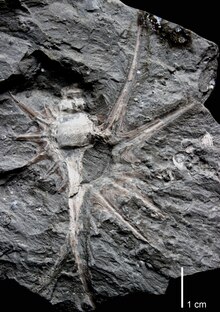| Harmatia | |
|---|---|

| |
| Harmatia tokodensis Kovács and Vicián, 2020. Size: 72 mm. Upper Lutetian–Lower Bartonian grey marl (Eocene), Tokod (Hungary). Hungarian Natural History Museum | |
| Scientific classification | |
| Domain: | Eukaryota |
| Kingdom: | Animalia |
| Phylum: | Mollusca |
| Class: | Gastropoda |
| Subclass: | Caenogastropoda |
| Order: | Neogastropoda |
| Superfamily: | Muricoidea |
| Family: | Muricidae |
| Genus: | †Harmatia Noszky, 1940 |
| Synonyms | |
|
† Murex (Harmatia) Noszky, 1940 | |
Harmatia is an extinct genus of sea snails, marine gastropod mollusks, in the subfamily Muricinae, the murex snails or rock snails.
Etymology
The taxon was named after István Harmat, Hungarian mine manager, fossil shell collector, friend of the author, Jenő Noszky Sr. (1880–1951), Hungarian geologist, paleontologist.
Description
Harmatia species are characterized by medium-sized, subfusiform shell, rounded spire whorls, long, narrow, slightly curved siphonal canal without cord spines, penultimate siphonal canal present, narrow primary spiral cords, three spiny varices per whorl, six long spines on the last whorl.
Distribution
This genus is known in the fossil record from the Middle Eocene – Early Oligocene period. Fossil shells within this genus have been found in Austria and Hungary.
Species
Species included in the genus:
- H. stephani Noszky, 1940. Type species. Early Oligocene, Hungary
- H. guembeli guembeli (Dreger, 1892). Early Oligocene, Austria
- H. guembeli longispina (Noszky, 1940). Early Oligocene, Hungary
- H. tokodensis Kovács & Vicián, 2020. Middle–Late Eocene, Hungary
References
- "Harmatia". The Paleobiology Database.
- "Harmatia Noszky, 1940". MolluscaBase.
- Noszky, Jenő (1940). "Die Molluskenfauna des Kisceller Tones (Rupelien) aus der Umgebung von Budapest. II. Teil: Loricata, Gastropoda, Scaphopoda". Annales Musei nationalis hungarici. 33: 1–80.
- Kovács, Z., Vicián, Z. (2019). "Muricidae (Neogastropoda) from the Middle Eocene of the Hungarian Paleogene Basin". Fragmenta Palaeontologica Hungarica. 36: 31–51. doi:10.17111/FragmPalHung.2019.36.31 – via ResearchGate.
{{cite journal}}: CS1 maint: multiple names: authors list (link) - "Harmatia stephani (Noszky, 1940) †". MolluscaBase.
- "Harmatia tokodensis Z. Kovács & Vicián, 2019 †". MolluscaBase.
- Merle, D., Garrigues, B. & Pointier, J.-P. (2011). Fossil and Recent Muricidae of the World. Part Muricinae. ConchBooks, 648 pp.
- Löffler, S.-B. (1999). Systematische Neubearbeitung und paläoökologische Aspekte der unteroligozänen Molluskenfauna aus den Zementmergeln von Bad Häring (Unterinntal, Tirol). Tübinger Geowissenschaft liche Arbeiten A: Geologie, Paläontologie, Stratigraphie 54: 1–207.
| Taxon identifiers | |
|---|---|
| Harmatia | |